Horwich
Horwich (/ˈhɒrɪtʃ/ HORR-itch) is a town and civil parish in the Metropolitan Borough of Bolton, Greater Manchester, England.[1][2] Historically in Lancashire, it is 5.3 miles (8.5 km) southeast of Chorley, 5.8 miles (9.3 km) northwest of Bolton and 20 miles (32 km) northwest of Manchester. It lies at the southern edge of the West Pennine Moors with the M61 motorway passing close to the south and west. At the 2011 Census, Horwich had a population of 20,067.[3]
| Horwich | |
|---|---|
 Horwich Parish Church | |
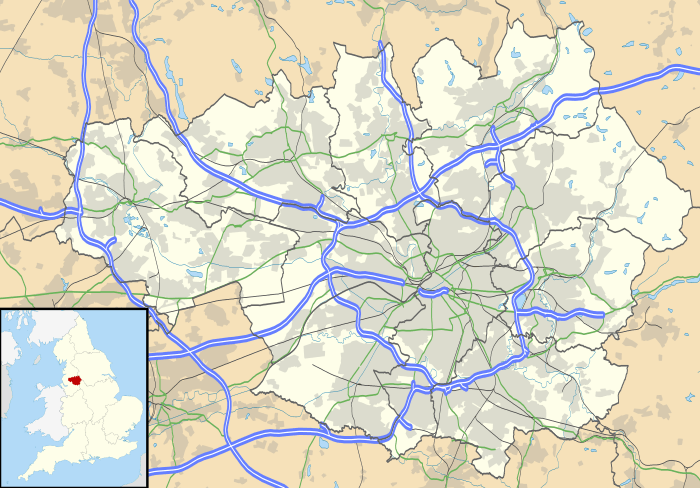 Horwich Location within Greater Manchester | |
| Population | 20,067 (2011 Census) |
| OS grid reference | SD639114 |
| • London | 177 mi (285 km) SE |
| Civil parish |
|
| Metropolitan borough | |
| Metropolitan county | |
| Region | |
| Country | England |
| Sovereign state | United Kingdom |
| Post town | BOLTON |
| Postcode district | BL6 |
| Dialling code | 01204 |
| Police | Greater Manchester |
| Fire | Greater Manchester |
| Ambulance | North West |
| UK Parliament | |
| Website | www.horwich.gov.uk |
Horwich emerged in the Middle Ages as a hunting chase. Streams flowing from the moors were harnessed to provide power for bleachworks and other industry at the start of the Industrial Revolution. The textile industry became a major employer and after 1884 the construction of the railway works caused the population of the town to increase dramatically. The old industries have closed and urban regeneration has been led by out of town developments, particularly at Middlebrook, which, since 1997 has been the base of Bolton Wanderers football club, who play at the University of Bolton Stadium, having moved from Burnden Park near Bolton town centre.
History
The name Horwich derives from the Old English har and wice, meaning the place at the grey wych-elm and in 1221 was recorded as Horewic.[4] The name was recorded as Harewych in 1277 and Horewyche in 1327.[5]
In the Middle Ages Horwich originated as a hunting chase for the barons of Manchester. It was held by Albert de Gresle between 1086 and 1100.[6] In 1249 Henry III granted Thomas Gresle free warren over his lands in "Horewich". The barons appointed foresters and trespassers in the forest were brought before the court baron or court leet for punishment.[7] In 1277 Robert Gresle the 7th baron prosecuted Martin de Rumworth for carrying off deer in Horwich Chase[8] which was described in 1322 as being within "a circuit of sixteen leagues, and is yearly worth in pannage, aeries of eagles, herons and goshawks, in honey, millstones, and iron mines, in charcoal-burning, and the like issues, 60 shillings; of which the vesture in oaks, elms and wholly covered with such, 160 marks."[5]
In 1598 a number of men were presented at the court leet for tithing and in 1621 the court leet recorded "paid for hue and crye that came from Horwich after the man who made an escape forth of ye stocks for stealing certain lynen cloth 8d."[5] By the 17th century the amount of woodland in the Horwich forest was reduced by house building and for fuel.[9][10] Horwich Moor was enclosed between 1815 and 1818 and race meetings were held between 1837 and 1847.[5]
The manor became the property of the Andertons of Lostock Hall, Lostock, who purchased it in 1599 from Nicholas and Elizabeth Mosley. These lands were confiscated by The Crown in 1715 after the Battle of Preston. They were leased to the Blundells whose coat of arms is displayed above the door at the Blundell Arms on Chorley Old Road.
The Pilkingtons were farmers who became gentry, Richard Pilkington was owner of rights in the Horwich Manor.[11] William Pilkington (1765–1831) became a physician and apothecary in St Helens and his sons Richard (1795–1869) and William (1800–1872) were the founders of Pilkington Glass.[12]
Industrial Revolution
In the 1770s brothers, John and Joseph Ridgway, land agents to the Blundells, moved their bleach works from Bolton to Wallsuches.[9][10] Their works was the oldest and one of the few stone-built mills in the Bolton borough.[13] The firm was one of the earliest users of chemical bleaching using chlorine.[14] In 1798 the firm installed a Boulton and Watt steam engine.[15]
Horwich Vale Printworks, founded in 1799 by the River Douglas, printed cloth using machines and handblocks.[15] On the slopes of Winter Hill, stone was quarried and there were several small collieries and a firebrick and tile works.[5] In 1896 the Montcliffe Colliery was owned by Adam Mason and Son and managed by Joseph Crankshaw and Joseph Kenwright. It employed 26 men underground and seven surface workers getting coal and fireclay from the Mountain coal seam.[16] Crankshaws pipeworks used the fireclay and had had several beehive kilns at their works at Tiger's Clough.[17] In the mid 19th century cotton mills were built by W. & W. Bennett and Peter Gaskell.[18]
Ridgways provided land for the early 19th century Club Houses, a grid pattern development of streets of stone built cottages south of Church Street. Some had basements for hand loom weaving. In 1851 the occupants were crofters, stovers and bleachers.[15] In 1881 the population of 3,761 lived in 900 houses, and had remained stable for fifty years. A rapid increase in population over the next ten years was caused by the arrival of the railway works and W.T. Taylor's cotton mill. In the late 19th century, brick terraced houses, in streets named after famous engineers, were built near to Horwich Works on both sides of Chorley New Road (A673) on company land.[15] The arrival of the railway and locomotive works to Horwich created a boom in population by 1891 to 12,850 people and was the most significant change to the town in the first Industrial Revolution, Horwich became a railway town.[19]
In 1937 the de Havilland Aircraft Company built a factory which supplied aircraft to Cobham's Flying Circus. During World War II the factory manufactured variable pitch propellers for Spitfires, making it a target for German bombers, who in July 1942 attempted to raid the factory by employing some of Germany's best pilots and crews in two Junkers JU 88 bombers in a mission using the Rivington reservoirs as landmarks to navigate at low level flying over the water then rooftops of Lever Park to find its target. The raid went off course due to low level cloud.[20] The company was taken over by Hawker Siddeley and subsequently British Aerospace, the site was halved and moved to the south side of Hall lane Lostock when taken over by MBDA in 1997 it is still in 2013 making missiles and the site is now used for integration and test purposes.[21]
Horwich Works
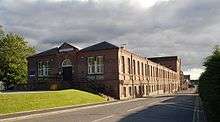
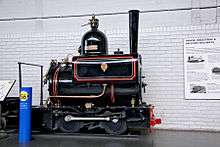
In spring 1884 the Lancashire and Yorkshire Railway (L&YR) began construction of a large complex for building and maintaining locomotives to replace its works at Miles Platting. Horwich Works was built on 142 hectares of land bought for £36,000. The first workshop, Rivington House opened in February 1887. It is 106.7 metres long by 16.8 metres wide. The long brick built workshops had full-height arched windows and were separated by tram and rail tracks. Work to construct the three-bay, 463.3 metres long, 36 metres wide, erecting shop began in March 1885. Inside it were 20 overhead cranes.[22] By November 1886 the first locomotives arrived at the works for repair. The first Horwich built locomotive, Number 1008, left the works in 1887 and is preserved at the National Railway Museum.[9][10][23][24]
In the First and Second World War, the works played a part in the war effort manufacturing tanks and munitions.[9][10]
The L&YR amalgamated with the London and North Western Railway in 1922 becoming a constituent of the London, Midland and Scottish Railway, (LMS) in 1923. Horwich Works continued to build and repair locomotives for the LMS until the company was nationalised in 1948 by the Transport Act 1947, becoming British Railways. In 1962, British Railways transferred control of its main works to British Railways Workshops Division, with its headquarters in Derby. In 1970 it was renamed British Rail Engineering Limited (BREL).[9][10][23][24]
The last steam locomotive built at Horwich Works left on 27 November 1957 and the last diesel built there left on 28 December 1962. It was reduced to repairing engines and maintaining railway wagons. On 18 February 1983 BREL announced that the works would close at the end of the year. Protest marches and spirited trade union resistance failed to alter the decision and at 1 pm on Friday, 23 December 1983 Horwich Works closed after 97 years.[9][10][23][24] The freehold of the railway works site was transferred from British Rail to Bolton Council in the mid-1990s.
A proposal to demolish the works and build 1,700 homes and a school was submitted to Bolton Council in early 2010.[25] The initial phase of the development commenced in 2019.[26]
Asbestos used to insulate steam engines and railway carriages linked to mesothelioma has been a legacy affecting former workers and their families with asbestos dust also being carried in clothing. The redevelopment of the site required it to be cleared of contaminants before building commenced.[27][28] Part of the site is planned for demolition for the creation of a link road in 2019, linking the Middlebrook Retail Park, M61 and Horwich Railway Station.[29]
Governance
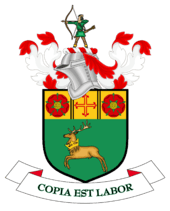
Lying within the county boundaries of Lancashire since the 12th century, Horwich was a township in the historic ecclesiastical parish of Deane, in the Hundred of Salford.[1] In 1837 Horwich joined with other townships and civil parishes to form the Bolton Poor Law Union and took joint responsibility for the administration and funding of the Poor Law in that area and built a workhouse in Farnworth.[30] The Horwich Local board of health was established in 1872 and was superseded by Horwich Urban District of the administrative county of Lancashire in 1894. Under the Local Government Act 1972 Horwich Urban District was abolished in 1974 and its area became a successor parish of the newly created Metropolitan Borough of Bolton in Greater Manchester.[1]
On 9 January 1974 Horwich was granted a Town Charter by the Earl Marshal, giving Horwich the status of a town, a town council and the ability to elect a Mayor. An official coat of arms was granted and assigned on 6 December 1974 by the Earl Marshal.[31]
Horwich is covered by two electoral Wards of the Bolton Metropolitan Borough Council, the Horwich and Blackrod, and Horwich North East Wards. Each Ward elects three councillors to the Metropolitan Borough Council. Horwich Town Council, formed in 1974, has six Wards; Vale, Bridge, Lever Park, Church, Claypool and Brazley, which elect 14 representatives to the Town Council.
Horwich is part of the Bolton West Constituency. Its Member of Parliament is Chris Green who won the parliamentary seat at the 2015 General Election.
Geography

Suburban localities in Horwich include Wallsuches and Middlebrook.
Horwich extends to 3,230 acres (13.1 km2) and measures 3 miles (4.8 km) from north to south and 2 miles (3.2 km) west to east. The River Douglas flowing in a south westerly direction forms part of its northern boundary.[18] The landscape to the north is dominated by Winter Hill, Rivington Pike and the West Pennine Moors. The highest point is 1,475 feet (450 m) on the moors in the north from where the ground slopes down towards the south and west, where the lowest land is about 350 feet (110 m). On Wilders and Horwich Moors the underlying rock is Millstone Grit, and in the intermediate slopes are found the Lower Coal Measures of the Lancashire Coalfield. The Middle Coal Measures are found in the southwest of the township.[5]
Red Moss, 1.5 km south of the town centre, is a 47.2 hectares (117 acres) Site of Special Scientific Interest (SSSIs) which was designated in 1995 because of its biological interest. Red Moss is the best example of lowland raised mire in Greater Manchester and is one of 21 SSSIs in the area.[32] The site is managed by the Wildlife Trust for Lancashire, Manchester and North Merseyside.[33]
Demography
| Horwich Compared | ||||
|---|---|---|---|---|
| 2001 Census | Horwich | Bolton (borough) | GM Urban Area | England |
| Total population | 19,312 | 261,037 | 2,240,230 | 49,138,831 |
| White | 97.9% | 89.0% | 90.3% | 90.9% |
| Asian | 1.0% | 9.1% | 6.2% | 4.6% |
| Black | 0.4% | 0.6% | 1.3% | 2.3% |
| Sources:[34][35] | ||||
At the 2001 UK census, Horwich had a population of 19,312 of which 9,370 were male and 9,942 were female. The 2001 population density is lower than Bolton at 12.5 people per hectare compared to 18.7 in Bolton. At the 2011 UK census, Horwich's population increased to 20,067 of which 9,777 were male and 10,290 were female. The 2011 census recorded a total of 9,013 households, of which were 1,979 detached houses, 2,642 semi-detached houses, 3,254 terraced houses, 971 purpose-built flats, 160 other flats (including bedsits), and 7 caravans (or other mobile or temporary structure).[36]
Population change
Until the late 18th century, Horwich was a small rural community. In 1774, it had a population of 305, comprising 156 females and 149 males.[37] After 1780 the population increased as the Industrial Revolution brought changes to the town but remained constant until 1885 when the locomotive works were built more than trebling the population in ten years.[9][10]
|
|
| ||||||||||||||||||||||||||||||||||||||||||||||||||||||||||||||||||||||||
| Sources: (a) Local Statistics.[38] (b) A vision of Britain through time.[39] (c) Neighbourhood Statistics.[40][3] | ||||||||||||||||||||||||||||||||||||||||||||||||||||||||||||||||||||||||||
Economy
Many of Horwich's traditional industries, Horwich Works and W.T. Taylor's cotton mill closed in the late 20th century. Regeneration was led by the construction of the University of Bolton Stadium for Bolton Wanderers at Middebrook in 1995. The development which stretches into neighbouring Lostock, attracted industrial and commercial users including Hitachi, generating jobs to replace those lost in the old industries and the area is now dominated by small and medium enterprises. E.ON and RBS have set up offices close the University of Bolton stadium.[21] Watson Steel Structures founded in 1933[41] and BAe's successor company, Matra BAe Dynamics operates from the Middlebrook area.[21] Georgia Pacific has a paper manufacturing plant close to the University of Bolton Stadium. Halbro, manufacturers of sportswear and equipment for both codes of rugby, is based on Chorley New Road.
There are Tesco and Asda stores on the outskirts of town and Aldi and Iceland stores closer to the town centre. EU grants have contributed to new "traditional style" shop fronts in the town centre, which has many small specialist shops. The Horwich indoor market building was closed and demolished in 2009 but there is a weekly outdoor market.[21][42]
Transport
Public transport is co-ordinated by Transport for Greater Manchester. The nearest railway stations are at Blackrod and Horwich Parkway adjacent to the University of Bolton Stadium where there is a Park and Ride facility with trains to Bolton, Manchester and Preston.[43] Blackrod station is nearer the town centre. The original Horwich railway station closed to passenger traffic on 27 September 1965.[44]
Frequent buses operate between Horwich and Bolton. The 575 is operated by Arriva North West, with Arriva services terminating in Wigan. Stagecoach Lancashire provide service 125 between Preston and Bolton via Chorley and Adlington.[45] Bus links to Middlebrook Retail Park are provided by Diamond Bus North West services 516 (Evening and Sunday services only), 517 and 518 which all between Horwich and Leigh via Westhoughton and Atherton. Service 576, which operates from Bolton to Wigan via the Middlebrook and Blackrod areas in Horwich also runs in the evenings.
Horwich is situated close to the motorway network with access at junction 6 of the M61 motorway. The A673 Bolton to Preston road passes through the town which is accessed by the B6226 and B5238.
Manchester Airport is 50 minutes by direct train from Horwich Parkway railway station.
Education
The Lancashire and Yorkshire Railway Company built the Railway Mechanics Institute in 1888. It became the Technical College but has been demolished.[15]
Horwich secondary school students years attend either Rivington and Blackrod High School, a Specialist Technology College which was originally the Rivington & Blackrod Grammar School on a site in Rivington close to the boundary with Horwich,[46] or St Joseph's RC High School on Chorley New Road.[47] The oldest school building is the old Horwich Parish School which was built as a National, Infant and Sunday School in 1793 and now used as a parish hall and is a Listed building.[48][49] Horwich Parish Church of England Primary School occupies the listed premises built in 1832.[50]
Our Lady's school was built in 1886 on Chorley New Road and Holy Family Primary School on Victoria Road in 1894. Holy Family was the first Lancashire County Council school to be granted aided status under the 1944 Education Act. The schools merged on the Victoria Road site as St. Mary's RC Primary School.[51]
| List of schools in Horwich | |||
|---|---|---|---|
| School | Type/Status | OfSTED | Website |
| Chorley New Road Primary School | Primary | 105178 | website |
| Claypool Primary School | Primary | 105195 | website |
| Horwich Parish CE Primary School | Primary | 105233 | website |
| Lord Street Primary School | Primary | 105179 | |
| St Catherine's CE Primary School | Primary | 132785 | website |
| St Mary's RC Primary School | Primary | 105250 | |
| Lever Park School | Special | 131692 | website |
| Rivington and Blackrod High School | Secondary & Sixth form | 105261 | website |
| St Joseph's RC High School | Secondary | 105262 | website |
| Alliance Learning | Work-based learning | 50387 | website |
Religion
Prior to the reformation a chapel of ease existed dedicated to St Mary's Church in Deane. In 1565 the commissioners for "removing superstitious ornaments" took various idolatrous items from the chapel.[5] The local population were forced by various means to conform to the Church of England and as with all other towns and villages across the country Catholicism was suppressed and it was not until 1886 when Father Hampson opened St Mary's Roman Catholic Church on Chorley New Road that the local Catholic population had a formal place of worship. The presbytery there was built by Father McGrath in 1906.[51]
After the English Civil War, with the contrivance of the vicar of Deane, the Chapel of Horwich was used by nonconformists and in 1669 a conventicle, meeting of nonconformists, was reported at Horwich and the ringleaders were prosecuted. In 1672 a nonconformist service was held at Old Lord's Farm, the home of the puritan Major Thomas Willoughby, a soldier of the Protectorate of Oliver Cromwell, who later become 11th Baron Willoughby of Parham. In 1716 Bishop Gastrell of Chester recovered the chapel for the established church.[5] The chapel was replaced in 1782 and rebuilt as Holy Trinity Church, a Commissioners' Church, in 1831. Until 1853 became a parish in its own right with Holy Trinity as the parish church.[9][10] After the non conformists were ejected from Horwich Chapel, Richard Pilkington built "New Chapel" between 1716 and 1719. It was enlarged in 1805. In 1890 the Unitarian Free Church was built on Church Street.[52] In the 18th and 19th centuries other nonconformist churches and chapels were built.[9][10]
Lee Lane Congregational Church, founded in 1754, closed in 2005 and was converted into a flats. It was originally built in 1856 on the site of an earlier build known as Horwich Lee Chapel built in 1774 on the site of an earlier house, also owned by Thomas Willoughby and was used for meetings from 1682 by Presbyterian members splitting away from the Rivington Unitarian Chapel as its doctrine changed.[53]
The Independent Methodist chapel in Lee Lane was built in 1867, Methodism had been practised from 1810. Primitive Methodists had a chapel on Horwich Moor and where a Baptist church was built in 1890.[5]
Sport
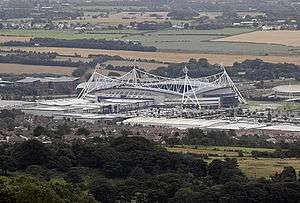
Bolton Wanderers F.C. play at the University of Bolton Stadium having moved from Burnden Park near Bolton town centre in 1997. Indoor facilities for sports training and major racket sports tournaments are provided at Bolton Arena, which was used for badminton events in the 2002 Commonwealth Games.[54]
Several of the town's sporting organisations have origins in the sport and social clubs of Horwich Locomotive Works. Horwich RMI Harriers and Athletic Club founded in 1924, is based at Middlebrook and participates in road, fell and cross country races, track and field athletics.[55] Horwich Cycling Club was founded in 1934 as the Horwich Wheelers.[56] It is involved in the organisation of the Horwich Carnival Road Races, held in the town centre.[57] Horwich RMI Cricket Club was founded in 1892. The club plays in the Bolton Cricket League which it joined in 1934.[58]
Twin town
In March 1990, Horwich and Crowborough, East Sussex entered into a unique twinning arrangement when they became the first towns within the United Kingdom to sign a town twinning charter. It was signed by the Mayors of Horwich and Crowborough at a ceremony in the Public Hall, Horwich on 22 March 1990 and the Town Hall, Crowborough on 27 March 1990.[59] On the 25th Anniversary of the Town Twinning, in March 2015, the Mayor of Horwich, Cllr. Richard E W Silvester and the Mayor of Crowborough, Cllr. Ronald G Reed signed 25th Anniversary celebratory Town Twinning documents in Crowborough Town Hall on Tuesday 10 March 2015 and in Horwich Public Hall on Thursday 19 March 2015, to re-new the twinning agreement. Horwich Cycle Club members travelled down to Crowborough on Friday 15 May 2015 and cycled with members of Wealden Cycle Club over that weekend as part of the celebrations.
Notable people
See also
References
- Greater Manchester Gazetteer, Greater Manchester County Record Office, archived from the original on 18 July 2011, retrieved 12 June 2010
- Horwich Township Map, genuki.org, retrieved 6 June 2010
- "Area: Horwich (Parish), Key Figures for 2011 Census: Key Statistics". Office for National Statistics. Retrieved 8 March 2016.
- Mills, A.D. (2003), A Dictionary of British Place-Names, Oxford: Oxford University Press, ISBN 0-19-852758-6(subscription required)
- Farrer & Brownbill 1911, pp. 6–9.
- Harland 1861, p. 39.
- Harland 1861, p. 96.
- Harland 1861, p. 70.
- Smith 1988, p. ?.
- Smith 1999, p. ?.
- Hampson 1883, p. ?.
- Barker, Theo; Harrison, B. (2006), "Pilkington family (per. c.1825–1925)", Oxford Dictionary of National Biography, Oxford University Press, doi:10.1093/ref:odnb/38700, retrieved 18 June 2010(subscription required)
- Bolton Mills Action Framework (PDF), Bolton Council, p. 6, archived from the original (PDF) on 15 June 2011, retrieved 23 June 2010
- Bolton, Spinning the Web, archived from the original on 3 October 2006, retrieved 23 June 2010
- Ashmore 1982, p. 98.
- North and East Lancashire's Mining Industry in 1896, projects.exeter.ac.uk, retrieved 8 November 2009
- Lane 2008, p. 13.
- Lewis, Samuel, ed. (1848), "Horwich", A Topographical Dictionary of England, British History Online, pp. 559–562, retrieved 11 June 2010
- "Horwich Official Town Guide" (PDF). Burrows. Horwich Town Council. Retrieved 10 July 2019.
- Lacey, Paul. "Bombers Over Rivington 1942". Internet Archive. Internet Archive. Retrieved 16 September 2019.
- Industry and Commerce, Horwich Town Council, archived from the original on 7 May 2007, retrieved 20 June 2010
- Horwich Locomotive Works, LYR, Engineering Timelines, retrieved 17 June 2010
- Simmons, Jack, (1986) The Railway in Town and Country, Newton Abbot: David and Charles (ISBN 0-7153-8699-9)
- Larkin, Edgar J. and Larkin, John G., (1988) The Railway Workshops of Great Britain, 1823–1986, London: Macmillan Press (ISBN 0-333-39431-3)
- "Historic Loco Works May become housing estate", The Bolton News, Newsquest Media Group, 20 January 2010
- Vesty, Helena. "What the £262m Rivington Chase development looks like now". Bolton News. Bolton News. Retrieved 11 September 2019.
- Abbit, Beth. "When Vivienne Swain washed her husband's overalls she never could have imagined fatal consequences". Manchester Evening News. Retrieved 11 September 2019.
- McIntyre, Alex. "Developer reveals decontamination of first phase at Horwich Loco Works". Bolton News. Bolton News. Retrieved 11 September 2019.
- Timan, Joseph. "Historic Bolton train yard to be demolished for new link road". Bolton News. Bolton News. Retrieved 11 September 2019.
- Workhouse, workhouses.org.uk, retrieved 13 December 2009
- Horwich Coat of Arms. Retrieved 29 March 2007.
- "Red Moss citation sheet" (PDF). Natural England. Archived from the original (PDF) on 13 October 2006. Retrieved 3 March 2007.
- Red Moss lnr, Lancashire Wildlife Trust, archived from the original on 20 July 2011, retrieved 25 November 2010
- Neighbourhood Statistics Horwich CP (Parish), Office for National Statistics, retrieved 25 June 2010
- Bolton Ward Profiles Horwich North East (PDF), Bolton Council, archived from the original (PDF) on 15 June 2011, retrieved 25 June 2010
- "Area: Horwich (Parish): Dwellings, Household Spaces and Accommodation Type, 2011". Office for National Statistics. Retrieved 19 March 2016.
- Smith 1988, p. 52.
- Tatton, Pauline. Local population statistics 1801–1986. Bolton Central Library Archives.
- Horwich UD: Total Population. URL accessed 29 November 2007.
- "Area: UK Census 2001: Horwich CP (Parish)". Office for National Statistics. Retrieved 8 March 2016.
- Watson Steel, Watson Steel Company, archived from the original on 15 March 2012, retrieved 30 November 2010
- "Asbestos fear for residents after market set alight", The Bolton News, Newsquest Media Group, 2 July 2009
- Horwich Parkway rail station, GMPTE, archived from the original on 2 March 2012, retrieved 13 June 2010
- Horwich station, Subterranea Britannica, retrieved 13 June 2010
- Transport, Horwich Town Council, archived from the original on 18 June 2010, retrieved 13 June 2010
- Welcome to Rivington & Blackrod High School, Rivington and Blackrod High School, archived from the original on 10 March 2009, retrieved 20 June 2010
- St Joseph's RC High School and Sports College, St Joseph's School, retrieved 20 June 2010
- Smith 1988, pp. 44–46.
- "Horwich Parish Hall, Former Horwich School, Horwich", British Listed Buildings, retrieved 25 June 2010
- "Horwich Parish Church of England Primary School, Horwich", British Listed Buildings, retrieved 20 June 2010
- St Mary, Horwich – Roman Catholic, GenUKI, retrieved 1 January 2011
- "Horwich Unitarian Free Church". National Archive. National Archive. Retrieved 17 September 2019.
- "Lee Chapel, Horwich Independent". GENUKI. GENUKI. Retrieved 17 September 2019.
- 2002 Venue (PDF), thecgf.com, retrieved 22 January 2010
- Horwich RMI Harriers, Horwich RMI Harriers, retrieved 18 June 2010
- Horwich Cycling Club, Horwich Cycling Club, archived from the original on 14 April 2010, retrieved 18 June 2010
- Horwich Carnival Races, Horwich Carnival Races, retrieved 18 June 2010
- Horwich RMI Cricket Club, Horwich RMI Cricket Club, retrieved 18 June 2010
- Horwich's Town Twinning. Retrieved 29 March 2007.
Bibliography
- Ashmore, Owen (1982). The Industrial Archaeology of North-west England. Manchester University Press. ISBN 978-0-7190-0820-7.CS1 maint: ref=harv (link).
- Farrer, William; Brownbill, J, eds. (1911). Townships: Horwich. A History of the County of Lancaster: Volume 5. British History Online. pp. 6–9. Retrieved 4 June 2010.CS1 maint: ref=harv (link)
- Hampson, Thomas (1883). Horwich: Its History, Legends, and Church. Wigan: "Observer" Office.CS1 maint: ref=harv (link)
- Harland, John (1861). Mamecestre: being chapters from the early recorded history of the barony; the lordship or manor; the vill, borough, or town, of Manchester, Vol. 53. Manchester: Chetham society.CS1 maint: ref=harv (link)
- Lane, Dave (2008). Winter Hill Scrapbook. Lulu. ISBN 978-1-4092-2068-8.CS1 maint: ref=harv (link).
- Smith, M.D. (1988). About Horwich. Chorley: Nelson Brothers Printers Limited. ISBN 0-9508772-7-1.CS1 maint: ref=harv (link)
- Smith, M.D. (1999). More About Horwich. St Michael's on Wyre: Wyre Publishing. ISBN 0-9526187-4-5.CS1 maint: ref=harv (link).
External links
| Wikimedia Commons has media related to Horwich. |
| Wikivoyage has a travel guide for Horwich. |